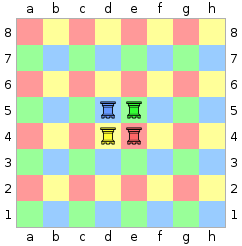Dabbaba (chess)
| a | b | c | d | e | f | g | h | ||
| 8 |  | 8 | |||||||
| 7 | 7 | ||||||||
| 6 | 6 | ||||||||
| 5 | 5 | ||||||||
| 4 | 4 | ||||||||
| 3 | 3 | ||||||||
| 2 | 2 | ||||||||
| 1 | 1 | ||||||||
| a | b | c | d | e | f | g | h | ||
Thedabbaba,also known as thedabaabaordabbabah,is afairy chess piecethat jumps two squares orthogonally (the directions arookcan move), leaping over any intermediate piece. Inalgebraic notation,it is given the symbolD.
History and nomenclature
[edit]The dabbaba is a very old piece, appearing in some very earlychess variants,such asTamerlane chess.[1][2][3]
The namedabbaba(Arabic: دَبَّابَة) means "tank"in Modern Arabic. In older Arabic, it referred to a type ofmedieval siege enginedesigned to shelter men who are digging a hole in enemy fortifications (Latin:vinea). The name has sometimes been translated as "war engine". The namedabbabawas also used for other pieces in old chess variants, such as one that moved like the modernbishop.[citation needed]
Value
[edit]
The dabbaba by itself is not much more powerful than apawn,but as an additional power to other pieces, it is worth about half aknight.Its value as a piece by itself is severely compromised by its being "twice-colourbound" —able to reach only a quarter of the squares on the 8×8chessboard.Combining it with other pieces usually masks this weakness to some extent. Akingand four dabbabas, with each dabbaba covering a different quarter of the chessboard, can easily forcecheckmateon abare king.
References
[edit]- ^Falkener, Edward(1961) [1892]. "XVI. Tamerlane's Chess".Games Ancient and Oriental and How to Play Them.Dover PublicationsInc. pp.197–216.ISBN0-486-20739-0.
- ^Pritchard, D. B.(1994). "Timur's Great Chess".The Encyclopedia of Chess Variants.Games & Puzzles Publications. pp. 314–15.ISBN0-9524142-0-1.
- ^Pritchard, D. B.(2007). "Timur's Great Chess". In Beasley, John (ed.).The Classified Encyclopedia of Chess Variants.John Beasley. pp. 270–71.ISBN978-0-9555168-0-1.
Bibliography
- Dickins, Anthony (1971) [Corrected repub. of 1969 2nd ed., The Q Press, Richmond, Surrey, England].A Guide to Fairy Chess.New York:Dover PublicationsInc.ISBN0-486-22687-5.
